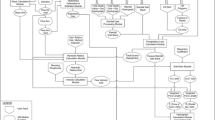Abstract
Hydrologic response is an integrated indicator of watershed condition, and significant changes in land cover may affect the overall health and function of a watershed. This paper describes a procedure for evaluating the effects of land cover change and rainfall spatial variability on watershed response. Two hydrologic models were applied on a small semi-arid watershed; one model is event-based with a one-minute time step (KINEROS), and the second is a continuous model with a daily time step (SWAT). The inputs to the models were derived from Geographic Information System (GIS) theme layers of USGS digital elevation models, the State Soil Geographic Database (STATSGO) and the Landsat-based North American Landscape Characterization classification (NALC) in conjunction with available literature and look up tables. Rainfall data from a network of 10 raingauges and historical stream flow data were used to calibrate runoff depth using the continuous hydrologic model from 1966 to 1974. No calibration was carried out for the event-based model, in which six storms from the same period were used in the calculation of runoff depth and peak runoff. The assumption on which much of this study is based is that land cover change and rainfall spatial variability affect the rainfall-runoff relationships on the watershed. To validate this assumption, simulations were carried out wherein the entire watershed was transformed from the 1972 NALC land cover, which consisted of a mixture of desertscrub and grassland, to a single uniform land cover type such as riparian, forest, oak woodland, mesquite woodland, desertscrub, grassland, urban, agriculture, and barren. This study demonstrates the feasibility of using widely available data sets for parameterizing hydrologic simulation models. The simulation results show that both models were able to characterize the runoff response of the watershed due to changes of land cover.
Similar content being viewed by others
References
Arnold, J.G., Williams, J.R., Srinivasan, R., King, K.W. and Griggs, R.H.: 1994, SWAT-Soil Water Assessment ToolUSDA, Agricultural Research Service, Grassland, Soil and Water Research Laboratory, Temple, Texas.
Bouwer, H.: 1966. 'Rapid field measurement of air entry and hydraulic conductivity as significant parameters in flow system analysis’ Water Resources Research 2, 279–238.
Branson, F.A., Gifford, G.F., Renard, K.G.and Hadley, R.F.: 1981, Rangeland HydrologySociety for Range Management, Kendall/Hunt Publishing Company, Dubuque, Iowa.
Breckenfield, D.J., Svetlik, W.A. and McGuire,C.E.: 1995, Soil Survey of Walnut Gulch Experimental WatershedUSDA-NRCS and ARS Special Report.
Fox, D.: 1999, Personal Communication.
Garbrecht, J. and Martz, L.W.: 1995, TOPAZ: An automated digital landscape analysis tool for topographic evaluation, drainage identification, watershed segmentation and subcatchment parameterization; overviewARS Pub. No. NAWQL95-1, USDA-ARS, Durant, OK, 16 pp.
Goodrich, D.C.: 1990, Geometric simplification of a distributed rainfall-runoff model over a range of basin scalesPh.D. Dissertation, Department of Hydrology and Water Resources, University of Arizona, 361 pp.
Hernandez, M., Lane, L.J., Stone, J.J., Martinez, J.G. and Kidwell, M.: 1997, ‘Hydrologic model performance evaluation applying the entropy concept as a function of precipitation network density,' in: International Congress on Modelling and Simulation ProceedingsUniversity of Tasmania, Hobart, pp. 65–70.
Jury,W.A.: 1985, Spatial variability of soil physical parameters in solute migration: a critical literature review, Electric Power Research Institute EA-4228 Project 2485-6 Interim Report, September 1985.
Rawls,W.J., Ahuja, L.R., Brakensiek, D.L. and Shirmohammadi, A.: 1992, ‘Chapter 5: Infiltration and water movement’ in: Handbook of HydrologyMaidment, D.R. (ed.), McGraw-Hill, Inc. NY, pp. 5.42–5.46.
Smith, R.E., Goodrich, D.C., Woolhiser, D.A.and Unkrich, C.L.: 1995, ‘Chapter 20: KINEROS-a kinematic runoff and erosion model’ in: Computer Models of Watershed HydrologySingh, V.P. (ed.), Water Resources Publications, Highlands Ranch, Colorado, pp. 697–732.
Stone, J.J., Lane, L.J.and Shirley, E.D.: 1992, ‘Infiltration and runoff simulation on a plane’ Transactions of the ASAE 35(1), 161–170.
Syed, K.S.: 1999, The impacts of digital elevation model data type and resolution on hydrologic modelingPh.D. Dissertation, Department of Hydrology and Water Resources, University of Arizona, 256 pp.
USDA Natural Resources Conservation Service: 1994, State Soil Geographic (STATSGO) Database, Miscellaneous Publication No. 1492.
USDA Soil Conservation Service: 1986, Urban Hydrology for Small WatershedsTechnical Release No. 55, U.S. Government Printing Office, Washington, DC.
USDA Soil Conservation Service: 1972, ‘Hydrology’ Section 4, Soil Conservation Service National Engineering HandbookU.S. Government Printing Office, Washington, DC.
DOCS/nalc_proj_camp.html
Woolhiser, D.A., Smith, R.E. and Goodrich, D.C.: 1990, KINEROS: a kinematic runoff and erosion modelUSDA., Agric. Res. Serv. ARS-77, 130 p.
Author information
Authors and Affiliations
Rights and permissions
About this article
Cite this article
Hernandez, M., Miller, S.N., Goodrich, D.C. et al. Modeling Runoff Response to Land Cover and Rainfall Spatial Variability in Semi-Arid Watersheds. Environ Monit Assess 64, 285–298 (2000). https://doi.org/10.1023/A:1006445811859
Issue Date:
DOI: https://doi.org/10.1023/A:1006445811859




